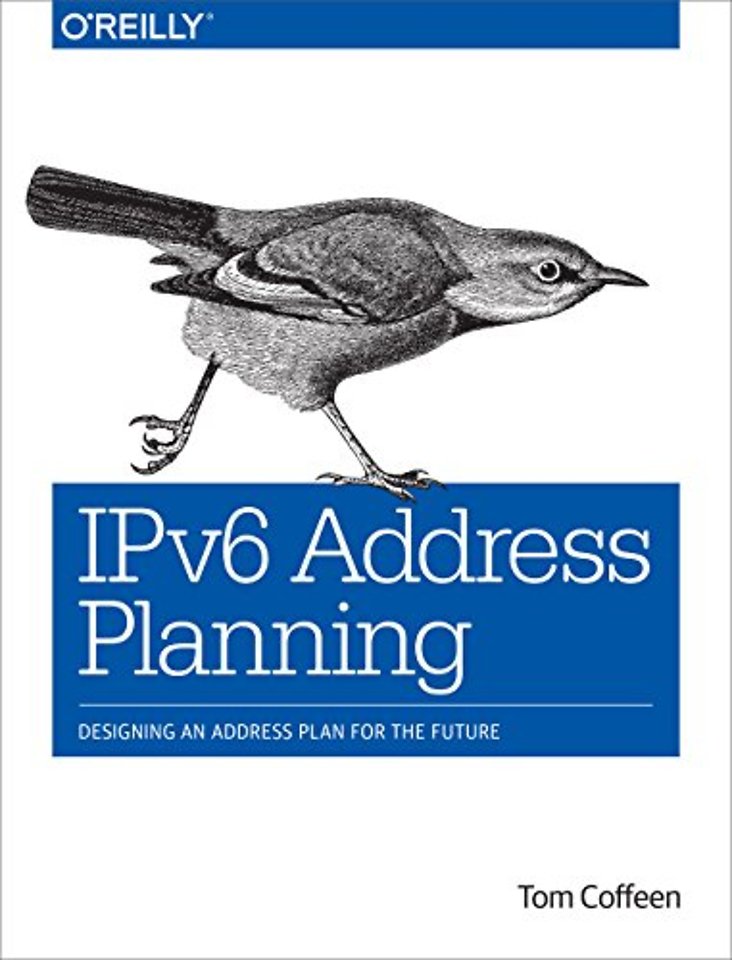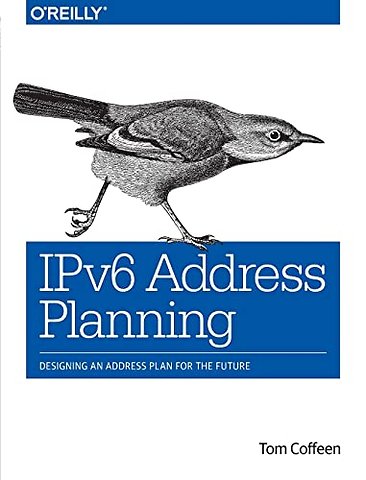IPv6 Address Planning
Designing an Adress Plan for the Future
Samenvatting
If you’re ready to join the move to IPv6, this comprehensive guide gets you started by showing you how to create an effective IPv6 address plan. In three example-driven sections—preparation, design, and maintenance—you’ll learn principles and best practices for designing, deploying, and maintaining an address plan far beyond what’s possible with IPv4 networks.
During the course of the book, you’ll walk through the process of building a sample address plan for a fictional company. Enterprise IT network architects, engineers, and administrators will see firsthand how IPv6 provides opportunities for creating an operationally efficient plan that’s scalable, flexible, extensible, manageable, and durable.
- Explore IPv6 addressing basics, including representation, structure, and types
- Manage risks and costs by using a three-phase approach for deploying IPv6
- Dig into IPv6 subnetting methods and learn how they differ from IPv4
- Determine the appropriate size and type of the IPv6 allocation you require
- Apply current network management tools to IPv6
- Use IPv6 renumbering methods that enable greater network scale and easier integration
- Implement policies and practices to keep IPv6 addresses reachable
Specificaties
Inhoudsopgave
Dedication
Preface
Who Should Read This Book
Why I Wrote This Book
Navigating This Book
Part I
Chapter 1, Where We’ve Been, Where We’re Going
Chapter 2, What You Need to Know About IPv6 Addressing
Chapter 3, Planning Your IPv6 Deployment
Chapter 4, IPv6 Subnetting
Part II
Chapter 5, IPv6 Address Planning Concepts
Chapter 6, Getting IPv6 Addresses
Chapter 7, Creating an IPv6 Addressing Plan
Part III
Chapter 8, Working with IPAM and DDI
Chapter 9, Managing Growth and Change
Chapter 10, Keeping Your IPv6 Addresses Reachable
Conventions Used in This Book
Safari® Books Online
How to Contact Us
Technical Reviewers
Acknowledgments
1. Where We’ve Been, Where We’re Going
Introduction
All the Stars in the Universe…
In the Beginning
A Dilemma of Scale
IPv4 Exhaustion and NAT
IPv6 Arrives
Why Not a “Flag Day” for IPv6?
Conclusion
I. Preparation
2. What You Need to Know About IPv6 Addressing
Representation
Structure
Types
Unicast Addresses
Multicast Addresses
Anycast Addresses
The Unspecified Address
Protocol Improvements
Subnetting Host Bits
Loopback Addresses
Point-to-Point Link Subnets
Host Address Assignment
The Problem with NAT
Practical Example: Production Loopback Addresses
3. Planning Your IPv6 Deployment
Introduction
The IPv6 Business Case You Already Have
IPv6 Adoption as a Cross-Functional Initative
A Phased Approach to IPv6 Adoption
Phase 1: Preparation
Management Buy-in
Training
Creating an IPv6 Task Force
Auditing Hardware and Software for IPv6 Support
Verifying That Your ISP Supports IPv6
Obtaining an IPv6 Address Allocation
Phase 2: External Adoption
Dual-Stack Eyeballs Are Happy Eyeballs
Phase 3: Internal Adoption
Reliance on NAT
IPv6 Business Case Redux
IPv6 (In)Security
Internal Adoption and Operational Wisdom
II. Design
4. IPv6 Subnetting
Introduction
Subnetting IPv4: A Brief Review
A Note on Efficiency
Nibble Boundaries
Prefix Legibility
Visualizing Hierarchy
Non-Nibble Subnetting
A Bit to the Left, a Bit to the Right
Subnets from the Right-Most Bits
Subnets from the Left-Most Bits
Subnets from the Middle Bits
Using Only Numeric Subnets
ipv6gen
5. IPv6 Address Planning Concepts
Introduction
IPv6 Address Planning Principles
Properly-Sized Initial IPv6 Allocations
Sparse Assignment of Subnets
Hierarchical Organization of Subnets
Uniform Subnetting and Summarization
Subnets in Reserve
Why Don’t I Use My Existing IPv4 Plan in IPv6?
Address Plan Structure
What Is a Site?
Intra-Site Versus Inter-Site Planning
IPv6 Allocation Methods
Best-Fit Allocation
Sparse Allocation
N+1 Allocation
Random Allocation
Assigning Subnets by Location or Function
VLAN-Mapped IPv6 Addresses
Summary
6. Getting IPv6 Addresses
Introduction
The IP Address Supply Chain
So Where Will Your IPv6 Addresses Come From?
How Many ISPs Do You Connect To?
How Large Is Your Organization?
So Why Doesn’t Everyone Just Get a PI Allocation?
Everything You Didn’t Realize You Wanted to Know About RIR Policy
Measuring IPv6 Address Consumption
Determining Initial Allocation Size
Navigating the IPv6 Address Request Process
RIR Allocation Request
ISP Allocation Request
Summary
7. Creating an IPv6 Addressing Plan
Introduction
Meet Strangelove Solutions, LLC
Edge Network
Campus Network
Lab Network
Data Center Network
Infrastructure
Where to Start: Topology or Plan?
Mapping Topology to Plan Between Sites
Mapping Plan to Topology Within Sites
Function and Location Assignment Revisited
Assigning Function and Location
Addressing the Data Center
Summary
III. Maintenance
8. Working with IPAM and DDI
Introduction
IP Address Management
IPAM as a Cornerstone of Network Management
Why More Than 1.8x1019 Addresses Aren’t a Substitute for Proper IPAM Addresses Aren’t a Substitute for Proper IPAM
IPAM Policy
IPAM Features
Example: Using IPAM Software
Adding an IPv6 Prefix
Splitting an IPv6 Prefix
Creating Reverse-Mapping DNS Zones
DDI: IPAM with 200% More Goodness
Managing DHCPv6 and IPv6 DNS
DHCPv6 Basics
Configuring DHCPv6 in DDI
DHCPv6 Challenges
DUID versus MAC
IPv6 DNS Considerations in DDI
IPv6 DNS Basics
Configuring IPv6 DNS in DDI
Summary
9. Managing Growth and Change
Introduction
Renumerology: IP Renumbering Made Easy…(or Somewhat Less Painful)
The Lifetime and State of an Autoconfigured Address
Preparing to Renumber
An IPv6 renumbering checklist
Address abstraction
Address lifetimes and DNS TTLs
The Renumbering Method
Frequent Renumbering
Unplanned Growth
An Address in Cloud City
The Internet of Things
Characteristics of IoT Devices
IPv6 Address Planning for IoT Deployments
Three Suggestions for IoT IPv6 Address Assignments
Summary
10. Keeping Your IPv6 Addresses Reachable
Introduction
Routing with IPv6
Selecting Your IPv6 Routing Protocol(s)
Operational Continuity
Distance Vector and Link State Routing Protocols
Dual-Stack…but Not Necessarily Dual Topology
IS-IS for IPv6: Single-topology or Multi-topology Mode
OSPFv3 Address Families
MP-BGP
Routing Table Size and TCAM Space
RIB versus FIB
Mars Needs IP Address Blocks
Attack of the Bogons!
Filtering Bogons
Summary
Glossary
A. Planning Worksheets
B. IPv6 Prefix Maps
C. Recommended Reading
Index
Anderen die dit boek kochten, kochten ook
Net verschenen
Rubrieken
- aanbestedingsrecht
- aansprakelijkheids- en verzekeringsrecht
- accountancy
- algemeen juridisch
- arbeidsrecht
- bank- en effectenrecht
- bestuursrecht
- bouwrecht
- burgerlijk recht en procesrecht
- europees-internationaal recht
- fiscaal recht
- gezondheidsrecht
- insolventierecht
- intellectuele eigendom en ict-recht
- management
- mens en maatschappij
- milieu- en omgevingsrecht
- notarieel recht
- ondernemingsrecht
- pensioenrecht
- personen- en familierecht
- sociale zekerheidsrecht
- staatsrecht
- strafrecht en criminologie
- vastgoed- en huurrecht
- vreemdelingenrecht







